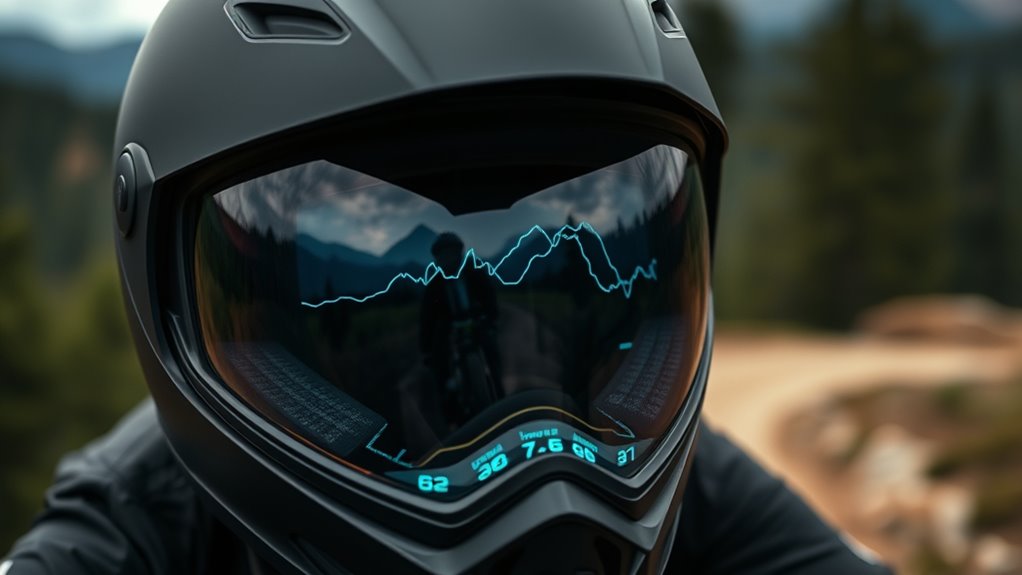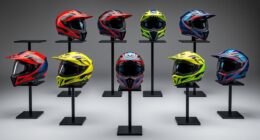Heads-up displays (HUDs) are set to revolutionize enduro helmets by offering real-time navigation, safety alerts, and environmental data right in your line of sight. Modern advancements focus on lightweight, durable designs that seamlessly integrate sensors, displays, and connectivity, improving safety and performance. Despite some integration challenges, upcoming helmets will become smarter, more intuitive, and better at enhancing trail awareness. Keep exploring to discover how these innovations will transform your riding experience.
Key Takeaways
- Future enduro helmets will feature customizable HUDs displaying real-time navigation, telemetry, and environmental alerts for enhanced rider awareness.
- Integration of lightweight sensors and advanced materials will improve safety, impact resistance, and comfort in HUD-equipped helmets.
- AI and sensor technologies will enable adaptive displays that learn rider preferences and adjust information dynamically.
- Challenges include compact integration of displays, sensors, and power sources without compromising helmet safety or increasing weight.
- Overall, helmet HUDs will evolve toward seamless, connected systems that improve safety, navigation, and rider engagement in diverse conditions.
The Evolution of Digital Helmet Technology
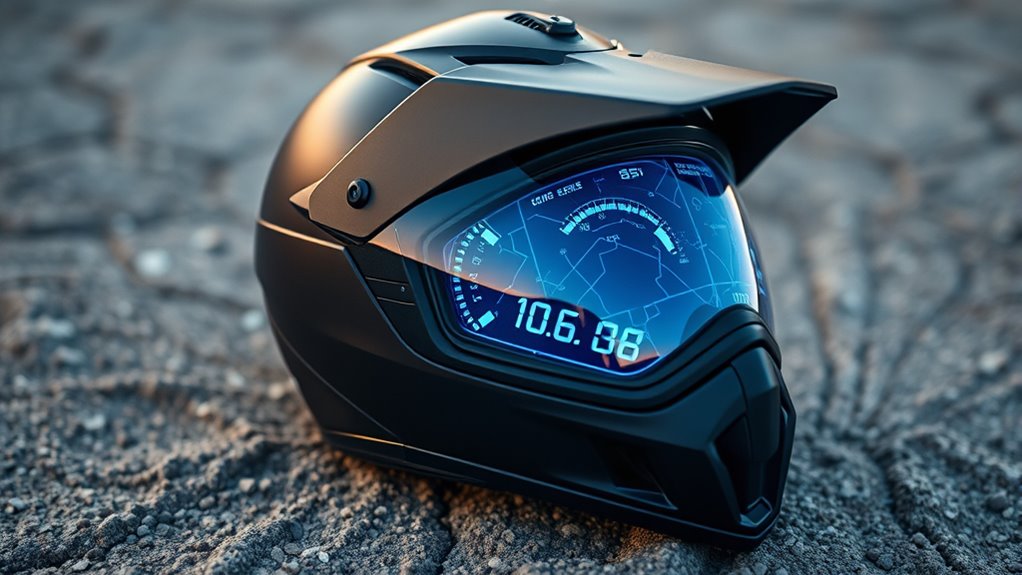
The evolution of digital helmet technology has transformed the way riders experience enduro riding. You no longer rely solely on traditional gauges or external devices; instead, integrated systems now provide real-time data directly in your line of sight. Early digital helmets focused on basic communication and simple displays, but advancements have rapidly expanded their capabilities. Modern helmets incorporate lightweight sensors, improved battery life, and more durable components. These innovations enhance safety, navigation, and overall performance. As technology progresses, helmets are becoming more intuitive, seamlessly blending data with your natural riding experience. Incorporating cognitive enhancement features, these helmets are paving the way for more sophisticated capabilities that will revolutionize how you approach and enjoy enduro riding.
Key Features and Functionalities of Future HUDs
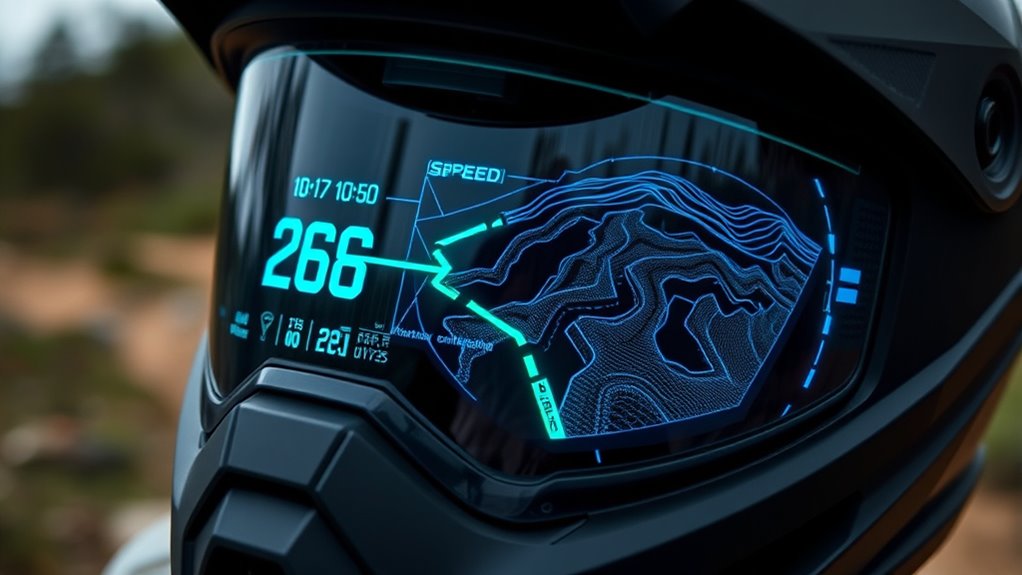
Future HUDs will deliver unprecedented levels of personalization and integration, allowing you to customize displays based on your riding style and environmental conditions. You’ll experience features like:
- Real-time navigation prompts that adapt to your route.
- Bike telemetry data, such as speed, RPM, and battery life, displayed seamlessly.
- Environmental alerts, including weather updates and trail hazards.
- Customizable visuals, enabling you to select the information you want front and center.
Additionally, conversion kits will facilitate the integration of advanced HUDs into various bike types, expanding their accessibility and functionality. These functionalities ensure you stay informed without distraction, enhancing safety and performance. Advanced sensors and AI will enable the HUD to learn your preferences and adjust displays accordingly. As a result, future HUDs will become integral tools that elevate your riding experience to new levels of efficiency and enjoyment.
Integration Challenges and Technological Barriers
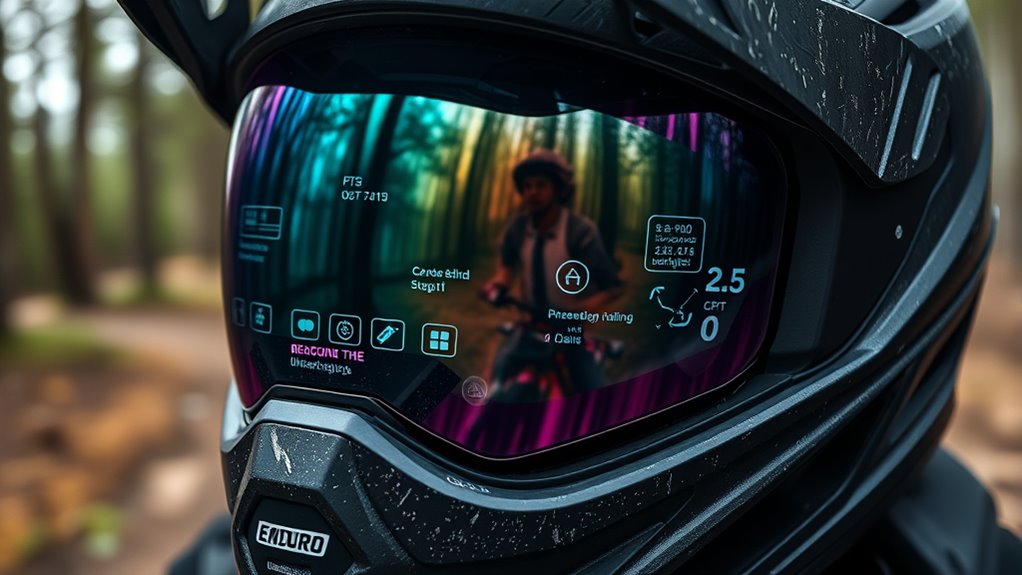
While the potential of HUDs in enduro helmets is exciting, integrating these advanced systems into helmets presents significant challenges. First, fitting high-tech components like displays, sensors, and power sources into the compact helmet shell is complex. You need to guarantee the system remains lightweight and comfortable without sacrificing safety or durability. Power management is a major hurdle; HUDs require reliable batteries that won’t add bulk or require frequent charging. Additionally, integrating these systems seamlessly with existing helmet structures demands precise engineering to prevent interference with safety standards. Confirming durability under rough conditions, like impacts and exposure to elements, adds further complications. Lastly, developing intuitive, user-friendly interfaces that don’t distract riders is essential—yet designing such systems remains a significant technological barrier.
Impact on Navigation and Trail Awareness

Heads-up displays considerably improve your trail visibility, so you can spot obstacles and landmarks more easily. With real-time route guidance, you’ll stay on track without stopping to check maps or devices. This technology keeps your focus on the trail while enhancing your navigation and awareness. Additionally, family dynamics play a role in shaping user experiences and perceptions of innovative gear.
Enhanced Trail Visibility
Enhanced trail visibility considerably improves your ability to navigate complex enduro routes, especially in low-light or challenging conditions. With heads-up displays, you can see critical trail details without diverting your attention from the path ahead. Here’s how they boost your trail awareness:
- Spot obstacles early, reducing crashes.
- Identify trail markers quickly, preventing wrong turns.
- Recognize terrain changes instantly, optimizing your riding line.
- Maintain focus on the trail, minimizing distractions.
- The integration of high-quality display technology ensures clear, sharp visuals even in adverse lighting conditions.
This heightened visibility helps you stay confident and in control, even when visibility is poor. You’ll respond faster to trail hazards and keep your flow intact. Overall, heads-up displays make trail navigation safer, more efficient, and more enjoyable, especially in conditions where natural visibility is compromised.
Real-Time Route Guidance
Real-time route guidance through heads-up displays considerably enhances your ability to stay on course during challenging enduro rides. Instead of stopping to check a map or GPS device, you receive clear, immediate directions directly in your line of sight. This minimizes distractions and helps you maintain focus on the trail. You can see upcoming turns, trail markers, and waypoints without losing momentum. The display updates dynamically, adjusting to your progress and route changes, so you’re always aware of the next step. This technology boosts your confidence, especially in unfamiliar or complex terrains, reducing the risk of getting lost. Overall, real-time route guidance improves your navigation efficiency, allowing for safer, more enjoyable rides with less mental effort spent on route planning.
Enhancing Safety and Performance Monitoring
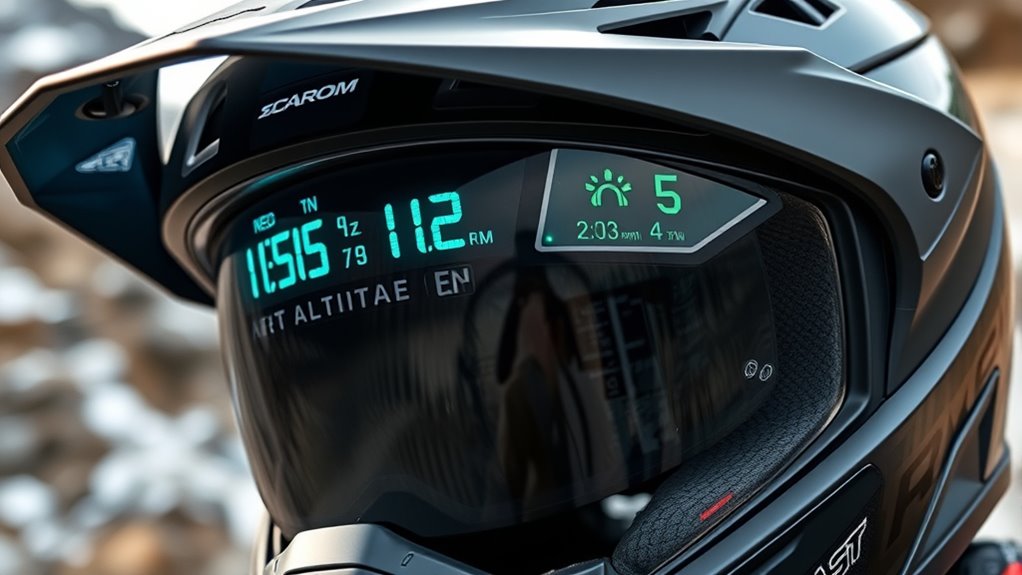
With heads-up displays, you can track your real-time performance data to optimize your riding. Alert and warning systems provide immediate feedback to help prevent mistakes or accidents. Plus, injury prevention features actively support your safety during challenging terrains. Exploring the paranormal and supernatural aspects of advanced helmet technology can reveal unexpected innovations and mysteries behind their development.
Real-Time Performance Data
Heads-up displays in enduro helmets provide crucial performance data that can immediately improve your safety and riding efficiency. With real-time information, you can make quick decisions on the trail. Here are four key benefits:
- Tracking your speed and RPMs to maintain ideal riding rhythm.
- Monitoring heart rate and fatigue levels to prevent overexertion.
- Analyzing terrain data to choose safer, faster lines.
- Receiving instant feedback on bike diagnostics like brake performance and suspension status.
This instant access helps you stay aware of your physical condition and riding environment without distraction. By continuously providing real-time insights, these displays enable you to adapt your riding strategy on the fly, enhancing both safety and performance during demanding enduro rides. Additionally, understanding security vulnerabilities associated with new technology can help riders better protect their data and devices.
Alert and Warning Systems
Alert and warning systems in enduro helmet displays actively monitor your riding conditions to detect potential hazards and performance issues before they become critical. These systems analyze data such as speed, rider fatigue, and environmental factors, providing real-time alerts to help you stay safe. If you’re approaching dangerous terrain or experiencing signs of fatigue, the system sends visual or auditory warnings, prompting you to take action. This proactive approach minimizes risks, helping you avoid accidents and maintain maximum performance. By integrating sensors and intelligent algorithms, these alert systems enhance your situational awareness without distracting you from riding. Additionally, understanding expiration indicators of safety equipment can ensure that the alert systems themselves are functioning optimally. Ultimately, they serve as an extra set of eyes, ensuring you stay informed and prepared for any challenges on the trail.
Injury Prevention Features
Injury prevention features in enduro helmet displays actively monitor your movements and essential signs to reduce the risk of harm during rides. These smart systems track your speed, heart rate, and fatigue levels, providing real-time feedback to help you stay safe. By alerting you to potential issues, they enable quick adjustments before problems escalate. Key features include:
- Impact sensors that detect collisions and trigger immediate alerts.
- Fatigue monitoring to prevent overexertion and exhaustion.
- Posture analysis to correct dangerous riding habits.
- Emergency communication that automatically contacts help if a crash occurs.
- Incorporating vetted safety features from trusted sources further enhances rider protection and confidence.
Together, these tools empower you to ride smarter, safer, and more confidently, minimizing injury risks and enhancing overall performance.
Consumer Expectations and Market Trends

As technology advances, consumers increasingly expect enduro helmets to incorporate innovative features like augmented reality displays that enhance safety and performance. You want gear that keeps you informed, connected, and confident on the trail. Market trends show a rising demand for smart helmets with integrated heads-up displays, real-time navigation, and performance metrics. Riders prioritize safety, convenience, and advanced connectivity. They’re also willing to invest in premium features that improve their riding experience. Here’s a snapshot:
| Consumer Expectations | Market Trends |
|---|---|
| Enhanced safety features | Growing adoption of AR and HUD technology |
| Real-time data access | Increased focus on lightweight, durable designs |
| Seamless connectivity | Rising popularity of integrated sensors |
| Customization options | Expansion into urban and adventure markets |
| Ease of use and comfort | Shift towards premium, tech-enabled gear |
Additionally, the integration of wearable technology into helmets signifies a significant shift toward more connected and intelligent riding gear.
Outlook: Innovations Shaping Tomorrow’s Enduro Helmets
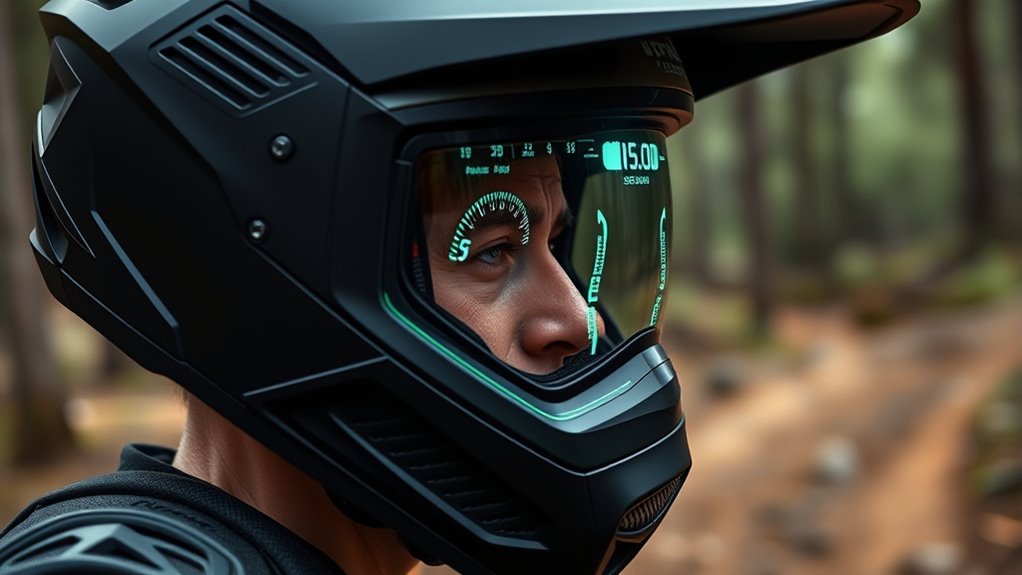
The future of enduro helmets is being reshaped by cutting-edge innovations that seamlessly blend safety, connectivity, and performance. These advancements will transform how you ride and stay protected. Here are four key innovations to watch:
- Integrated Heads-Up Displays (HUDs) that provide real-time navigation, speed, and environmental data.
- Smart sensors that monitor your essential signs and helmet integrity, alerting you to potential issues.
- Enhanced ventilation systems with adaptive airflow to keep you comfortable during intense rides.
- Advanced materials like carbon nanotubes for lighter, stronger helmets that absorb impacts better.
Additionally, the integration of safety-enhancing materials ensures increased durability and impact resistance for riders. These innovations aim to make your riding experience more intuitive, safer, and more connected. As technology evolves, expect your enduro helmet to become an even smarter, more integral part of your gear.
Frequently Asked Questions
How Will HUDS Affect Helmet Weight and Rider Comfort?
You might worry about added weight and comfort when considering HUDs in helmets. Modern designs focus on lightweight materials and compact tech, so the impact on weight is minimal. You’ll likely notice only a slight increase, but it shouldn’t compromise comfort. As technology advances, manufacturers aim to keep helmets light and ergonomic, ensuring you stay comfortable and focused during your ride without feeling burdened by extra gadgets.
What Are the Privacy Concerns With Helmet Data Collection?
Did you know that over 70% of riders worry about their helmet data being misused? Privacy concerns include unauthorized tracking, data breaches, and sharing your riding info without consent. You might feel uneasy knowing your location or performance stats could be accessed by third parties. To protect yourself, always review data policies, choose helmets with strong security features, and stay informed about how your personal data is collected and used.
Will HUDS Be Compatible With Existing Helmet Models?
You wonder if HUDs will work with your current helmet model. Compatibility depends on whether your helmet can support the necessary tech upgrades or if you need a new helmet designed specifically for HUD integration. Some manufacturers may offer retrofit kits, but many models will require a compatible helmet. To guarantee seamless use, check with the manufacturer or expert installers about compatibility and potential modifications for your existing helmet.
How Durable Are Future HUDS in Extreme Riding Conditions?
Imagine you’re riding through a thunderstorm, just like a knight facing a storm in medieval tales. Future HUDs are designed to be incredibly durable, built with advanced materials that withstand extreme conditions like mud, rain, and vibrations. You can expect them to hold up well in harsh environments, providing reliable info without faltering. Manufacturers focus on durability, so your HUD stays functional during your toughest rides, ensuring safety and performance.
What Is the Expected Cost Range for Advanced Hud-Equipped Helmets?
You’re probably wondering about the cost of advanced helmets with HUD technology. Currently, expect to pay between $500 and $1,200 for high-end models with integrated displays, sensors, and durable materials. As technology advances and demand increases, prices may decrease, making these helmets more accessible. Keep in mind, investing in a quality HUD helmet can enhance your safety and riding experience, justifying the initial expense.
Conclusion
As heads-up displays become the compass guiding your ride, they’ll transform your enduro helmet into a tech-powered adventure partner. Expect seamless integration, real-time insights, and safer, smarter trails—like having a trusted co-pilot by your side. While challenges remain, embracing these innovations will elevate your riding experience from ordinary to extraordinary. Get ready to navigate the future, because it’s a trail waiting to be explored with clarity and confidence.
